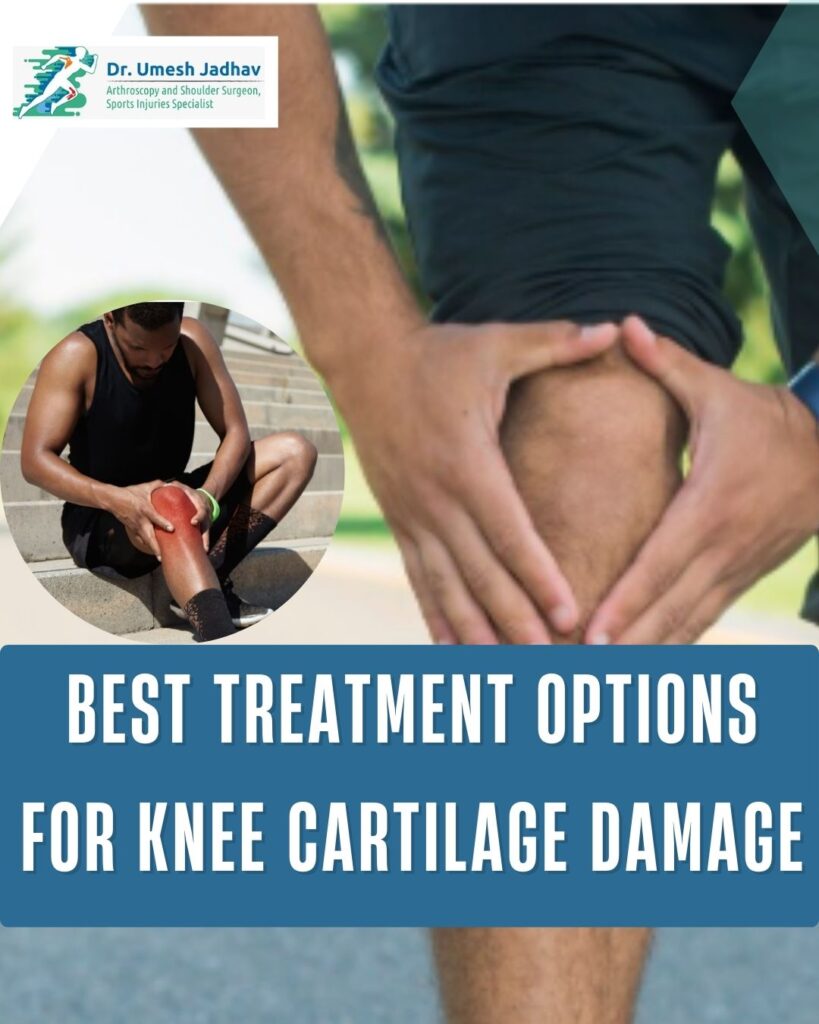Did you know that nearly 1 in 4 adults experience knee cartilage damage at some point in their lives? This condition is no longer limited to older adults—it is increasingly seen in younger people due to sports injuries, obesity, sedentary lifestyle, and accidents. Unlike muscles or skin, knee cartilage does not regenerate naturally because it lacks a direct blood supply. That means untreated cartilage injuries can lead to chronic knee pain, stiffness, limited mobility, and early osteoarthritis.
If you ever notice persistent knee pain, don’t ignore it—visit your nearest orthopedic clinic for an early evaluation and expert advice on knee cartilage health.
In this blog, we’ll explore the best treatment options for knee cartilage damage, from non-surgical therapies to advanced surgical procedures, helping you make an informed decision about your joint care.
Non-Surgical Treatment Options for Knee Cartilage Damage
If your cartilage damage is in the early stages, you might not need surgery. Here are some effective non-surgical knee cartilage repair treatments:
Physical Therapy
Think of this as retraining your knee. Targeted exercises improve muscle strength, balance, and flexibility—taking pressure off the damaged cartilage. A physiotherapist will usually customize a plan based on your daily activities.
Medications
Anti-inflammatory drugs or pain relievers won’t “repair” the cartilage but can help you stay active and manage pain while other treatments take effect.
PRP (Platelet-Rich Plasma) Therapy
This sounds high-tech—and it is. PRP uses your own blood platelets, concentrated and injected into the knee, to reduce inflammation and encourage tissue healing. Many athletes turn to this option for faster recovery.
Stem Cell Therapy
A newer regenerative method, stem cells may help stimulate cartilage regrowth. It’s minimally invasive and often combined with physiotherapy for better results.
Tip: Non-surgical options are best for mild to moderate damage or if you want to delay surgery.
Surgical Treatment Options for Knee Cartilage Damage
When the damage is more severe, surgery becomes the most effective option. Don’t worry—it’s not always as scary as it sounds. Here are the main choices:
Microfracture Surgery
Imagine your doctor creating tiny holes in the bone under the cartilage. This triggers the body to form new tissue in the damaged area. It’s often used for small cartilage injuries.
Autologous Chondrocyte Implantation (ACI)
Here’s where science gets fascinating. Doctors take some of your healthy cartilage cells, grow them in a lab, and then implant them back into your knee to repair the damage.
Cartilage Grafting (Osteochondral Autograft or Allograft)
Think of it as a “patch job.” Healthy cartilage is transplanted from another area of your knee (or a donor) to replace the damaged section.
Knee Cartilage Replacement
In advanced cases, when damage is too widespread, cartilage replacement or partial knee replacement surgery might be the best way forward.
Tip: Surgical treatments usually require longer recovery but offer lasting solutions for severe cartilage injuries.
Recovery and Rehabilitation
Here’s the part most patients are curious about: “How long until I can walk, run, or play sports again?”
-
Non-surgical recovery → With PRP, stem cell therapy, or physiotherapy, patients often start feeling better in a few weeks to 2 months.
-
Surgical recovery → Depending on the procedure, expect 3–6 months of rehab, sometimes longer for high-impact sports.
Rehabilitation usually includes:
Physiotherapy exercises (strength + mobility)
Gradual return to activities (walking first, then jogging, then sports)
Lifestyle changes—like maintaining a healthy weight to reduce joint pressure
Tip: Recovery is as important as the treatment itself. Skipping rehab can undo all the progress.
FAQs on Knee Cartilage Damage
1. Can knee cartilage heal naturally?
Unfortunately, no. Since cartilage has no direct blood supply, it can’t heal by itself. Early treatment is the key.
2. Is surgery always necessary?
Not always. Many patients manage well with PRP, stem cell therapy, or physiotherapy before needing surgery.
3. How long does recovery take?
Anywhere from a few weeks (non-surgical) to several months (surgical), depending on the severity and treatment.
4. Who is most at risk?
Athletes, older adults, people who are overweight, and anyone with a past knee injury.
Conclusion
Knee cartilage damage doesn’t have to mean giving up on mobility or an active lifestyle. With today’s advanced treatment options—from physiotherapy and PRP injections to microfracture and cartilage replacement surgeries—you can restore function and prevent long-term complications.
For a thorough evaluation and the best knee cartilage repair treatments in Nigdi, PCMC, consult Dr. Umesh Jadhav, an experienced orthopedic specialist and surgeon known for advanced joint preservation and surgical expertise. Early intervention is your best chance for a pain-free, active future. Visit our clinic if looking for knee cartilage treatments.

